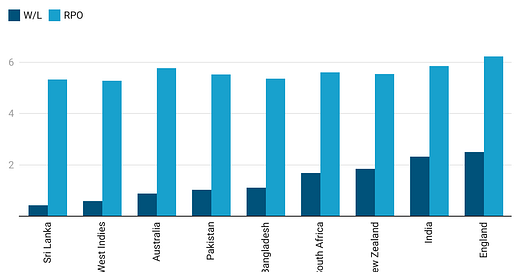Is India's approach to ODI batting outdated?
Since 2017, only two major teams have a W/L ratio better than 2 - India is one of them.
Since 2017, there are only two teams, England and India, with a W/L ratio of greater than 2 whether batting first or chasing (with New Zealand third on the list both times). Yet, both teams have very different approaches to ODI batting. England, very similar to the T20 squad, believes in batting deep and going hard right away to set up big targets or chase down targets easily. The Indian team takes their time in the PowerPlan, tries not to lose too many wickets by the 30-over mark, and then aims to double the score of 32 overs (or so).
A lot of people consider England’s method “the way of the future”. Here’s a recent take I came across:

This isn’t an unreasonable point of view. Pitches in ODIs have become flatter than ever before and then you add those big bats and aggressive batsmen - it’s understandable why teams would like to pick hard-hitting batsmen. Even a look at the W/L ratio since 2017 in comparison to runs scored per over will tell you the teams that score faster generally have a better chance of winning around the world.
Additionally, England is the only team to have scored 400 in an ODI since 2017 and they have done it more than once. They also won the 2019 World Cup at home and have become a solid T20I side. So there are plenty of reasons to see England’s methods are the right way to approach ODIs.
Here’s a comparison of India and England when they bat first -
As suspected, England makes the high scores more consistently. However, India seems to do a better job defending scores of 300. In fact, India has a higher W/L ratio than England when they score 300 or higher. Even while bowling first, England seems to concede high targets more often than India even though their W/L ratio is a little better than India.
Looking a little closer at bowlers with at least 20 ODIs since 2017, every Indian bowler with the exception of Mohammed Shami has a better economy rate than their English counterparts. This is expected because, apart from Ravindra Jadeja and Hardik Pandya, India looks to pick proper bowlers as compared to England, who often have the Curran brothers, Chris Jordan and Moeen Ali batting as low as 9 or sometimes even 10.
This doesn’t indicate that England would continue to pick all-rounders over proper bowlers if they had more options. Look at Jofra Archer - England has persisted with him because of his fantastic returns despite his batting abilities not being the same level as someone like Moeen Ali or even Tom Curran. This is likely a product of the type of cricketers England is producing, but I really doubt England (or anyone really) would drop someone like Jasprit Bumrah if they had someone of his capability available for selection.
From India’s perspective, it’s not like India doesn’t have hard-hitting bowlers. The likes of Krishnapa Gowtham, Krunal Pandya, and even Kamlesh Nagarkoti are around, but India chooses to pick proper bowlers with 1-2 all-rounders. Considering England’s returns in this period, is it fair to say India’s approach is incorrect?
Not really. While England has done well, their W/L ratio away from home since 2017 is just 1.7. England’s approach has allowed them to be extremely consistent on good batting wickets, yet it is 1-dimensional which leaves them vulnerable when the conditions have a little bit for the bowlers. Even at the World Cup, England was on the verge of getting knocked out after losses to Pakistan, Australia, and even Sri Lanka.
Based on the recent trends around tough pitches in tests, if countries start preparing more bowling-friendly tracks in LOIs, England will need to re-think their strategy and maybe bring back someone like Joe Root to play anchor. India, with “an archaic approach” as per some experts, has the best W/L ratio away at 2.6 and has been a consistent side winnings series in New Zealand and South Africa.
Additionally, India has been the most consistent side in ICC tournaments in the period, staying unbeaten until the knockouts in both CT ‘17 and WC ‘19. Therefore, India’s approach is quite effective and gets more scrutiny than it deserves. Both the teams have an imperfect approach, but it has a lot to do with the kind of talents that they possess.







different conclusion in the end , than what heading stated
liked the article. Root was purely rested for this series. he should be back for england in ODI's for #3. He is the banker. In T-20's even though David Malan does not exactly fit Englands idea 100% still he is essentially playing the same role Root's playing in ODI's. Really liked the point about Jofra, is that the reason why they hesitated to play topley ahead of Curran brothers knowing that he does not bat & based on evidence topley is the better death bowler. His death bowling skills has not diminished even after injury.